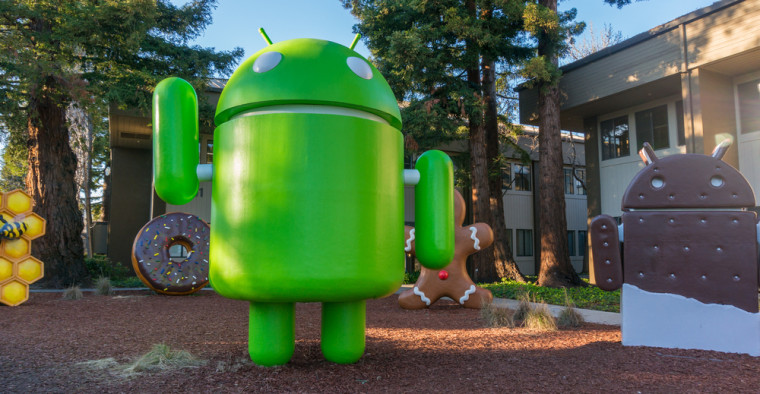It was teased last May during the Google I/O 2015 keynote. At the time Android M was debuted as a pre-release and Google’s Sundar Pichai stated the company had “gone back to the basics” and improved quality of the platform for users. After months of speculation, Google finally announced on August 17 Android M’s its proper name: Android 6.0 Marshmallow.
Until Marshmallow is official, here’s everything that you should know about Android 6.0.

Why is Marshmallow Version 6.0 of Android?
Naming Android 6.0 Marshmallow wasn’t really that far of a stretch. After all, Android has been known to name new versions after tasty treats in the past. But, why did this version go from 5.0 to 6.0?
Programmers usually mark a major version by the first number, like 1.0 or 2.0 The second number version is normally a minor version, like 2.2. So going from 5.0 to 6.0 could signify that this is a major update to Android. However, this numbering system isn’t really set in stone. Traditionally, it’s just a way to track when a new version was replaced.
The thing is, if you’re an Android user, you probably already realized that Google’s version system was never consistent. And, it’s sometimes a bit confusing.
Here’s a look back at the previous Android versions to give you a better understanding of that inconsistency:
- Android 1.0
- Android 1.1
- Android 1.5 Cupcake
- Android 1.6 Donut
- Android 2.0 Éclair
- Android 2.2 Froyo
- Android 2.3 Gingerbread
- Android 3.0 Honeycomb
- Android 4.0 Ice Cream Sandwich
- Android 4.1 (4.2, 4.3) Jelly Bean
- Android 4.4 Kitkat
- Android 5.0 Lollipop
As you can see, there really isn’t any rhyme or reason. Some would argue that whole numbers would mean an aesthetic change. But, that didn’t happen with Éclair. And, it probably won’t with Marshmallow either. It’s even been mentioned that the names are for users and would mark updates that involved function. But, again, that’s not really the case. In short, there’s really no straightforward answer here.
It’s being speculated that Marshmallow could actually be a major Android update. There are some exciting new features, such as Android Pay and Google Now on Tap, that could make Version 6.0 worthy of getting a whole number. Then again, previous versions like Jelly Bean also had some promising features that could have earned them a whole number.
Another theory is that maybe Marshmallow is attempting to distance itself from Lollipop. There were plenty of Android users who less than thrilled with Lollipop and its numerous bugs. And, there’s been other instances of updates skipping ahead – Microsoft went from 8 to 10. The idea with this move is that if you didn’t like Lollipop, then give Marshmallow a chance.
Which Phones are Compatible?
The HTC One M9 and One M8, Google Nexus 6, and Nexus 5 have already been confirmed by Google to receive a Marshmallow update. Samsung has unveiled its Galaxy Note 5 and Galaxy S6 Edge+, which should also receive a Marshmallow update.
What are the Marshmallow Features?
As mentioned earlier, Google wants Android 6.0 Marshmallow to go back to basics. As opposed to Lollipop’s more design-centric update, Marshmallow will primarily focus on improving existing features and fixing all of those thousands of bugs that became synonymous with Lollipop.
As of this writing, here are eleven of those Marshmallow features that should have Android phone and tablet users salivating.
1. App Permission
You just downloaded a new app on Google Play and then you’re asked to give the app developer permission to access a laundry list of items from your device. What if you don’t want to do that? Google has finally resolved this issue by letting you select which functions you want the app to have access to. For example, if you don’t want WhatsApp to know your location you can disable that function in the app permission list. If you allowed WhatsApp to use the microphone then you can make phone calls.
This is a great feature if you’re a little nervous about giving an app free rein of your contacts, images, or location. This may not end every data-driven security concern, it’s a refreshing start.
2. Google Now on Tap
The is arguably the most obvious and coolest new feature. In a nutshell, Google Now on Tap takes Google Now and actually spreads it out across the entire operating system. This means you can now use Google’s virtual assistant no matter where you are or what you’re doing on your device. All you have to do is hold down the home button and Now will appear from the bottom of the screen. For example, if you and your spouse are discussing dinner plans for the night over text messages, you could use Now to get restaurant suggestions and then learn more about that restaurant. If you’re watching a movie trailer on YouTube, Now could locate local screening times or pull-up IMDb for more information.
Since this is accomplished by intelligent search algorithms, Marshmallow is able to scan the content that you’re currently looking at and then offer information around that. The result? More conversational interactions as Now will constantly learn and deliver search results based on context. It’s kinda scary, but awesome at the same time.
3. Android Pay
To compete with Apple Pay and Samsung Pay, Google has revamped its own mobile payment service, which was introduced all-the-back in 2010 on the Android Gingerbread. Android Pay is expected to be compatible with phones that run on Android KitKat and above and will let you shop in stores by just tapping on an NFC terminal to pay for your goods.
All you have to do is create a virtual account number, which is safe and secure since that number isn’t shared with the retailer. Android Pay is anticipated to work with approximately 700,000 stores in the US and will also work with existing credit and debit cards. Instead of pulling out our credit or debit cards, we’re on the way to paying for stuff via our phones to speed the process up.
4. Quick Fingerprint Access
This feature will actually tie-in in with Android Pay since you can now use your fingerprint to log into apps like Google Play Store and make online purchases with just your digit. Of course, you can use fingerprint access to unlock your phone, which seems a whole lot better than having to enter your password every time you use your phone.
5. Doze
We’ve heard this promise before, but Google is once again promising to improve battery life. What makes Marshmallow different, however, is that it is standby power that’s getting updated. The Doze feature is a new technology that can detect when your device is either motionless or not being used. Doze then puts your device into a deeper sleep mode and cuts out background services. Don’t worry if someone is calling or texting you. Those notifications will still go through.
According to Google’s internal tests, Doze has been able to double the battery life on a Nexus 9 tablet.
6. Track Memory
Were you ever curious which apps are using the most memory on your phone? Marshmallow can now reveal that information with the Track Memory feature. Just click on the Memory tab and you’ll be able to how much memory, such as cache or installation, your apps are taking up on your device. You can also use this feature to see how frequently apps are running and remove or uninstall the apps that are draining your memory the most.
7. Auto Backup
Have you ever switched a device and lost all of your app data? It’s pretty frustrating, right? Marshmallow will make sure that won’t happen again since it will automatically backup all of your user data onto Google Drive. It’s believed you can store up to 25MP per app.
8. USB Type-C
USB Type-C is intended to eventually replace all types of USB on both hosts and client devices since it’s reversible. Apple has already announced that its next generation of MacBook will have support for this new USB standard. The Chromebook Pixel currently includes this USB Type-C support.
Where does Marshmallow fit into this? The latest version of Android will offer full support for Type-C. This is a step into being able to charge your Android phones and tablets more quickly and conveniently in the very near future.
9. Direct Share and Floating Toolbar
I’ve put these two small, but clever features, together. With Direct Share, your device has the power to learn who you share content with the most so that you can share content with just the push of one button. As for the floating toolbar, this feature will make it easier to copy and paste content from webpages or documents.
10. Multi-App, Split-Screen Support
Marshmallow to run two apps side-by-side. While this isn’t the first time that we’ve seen this feature, it was previously found on Samsung’s Note devices, it’s a new feature new for Google’s version of Android. If you’re a Nexus 6 user you should be a real big fan of this feature.
11. Chrome Custom Tabs
Google is also attempting to enhance the web experience for phone users with the new Chrome Custom Tabs. Whenever an app wants you to open web view, you can create custom tabs that will load on top of the app. This prevents you from having to open a new browser and should make web content smoother. The tabs will also support automatic sign-ins, saved passwords, and autofill. This was designed with app developers in mind.
There are other features, like simplified volume controls and improved linking between apps, but the features mentioned above should help us forget all about the bugs users dealt with from Lollipop.
When Will Marshmallow be Released?
Android users can expect to see Marshmallow released sometime this fall – most likely November. But, that also depends on the device you own.
Google’s Nexus phones should be the first to receive the Marshmallow update – they’ve already been a part of the developer preview. Because Google should be releasing one, maybe two, brand new Nexus phones this years, users could perhaps see Marshmallow earlier than November.
If you’re not a Nexus user, you’re going to have to wait a little bit longer. Keep in mind that some manufacturers like to impose a 90-day deadline. This would mean that Android users may have to wait until the end of the year to get Marshmallow.
What features are you most excited for when Android Marshmallow is released?
Image Credits
Featured Image: Natali Zakharova/Shutterstock.com
In-post Photo: Asif Islam/Shutterstock.com




